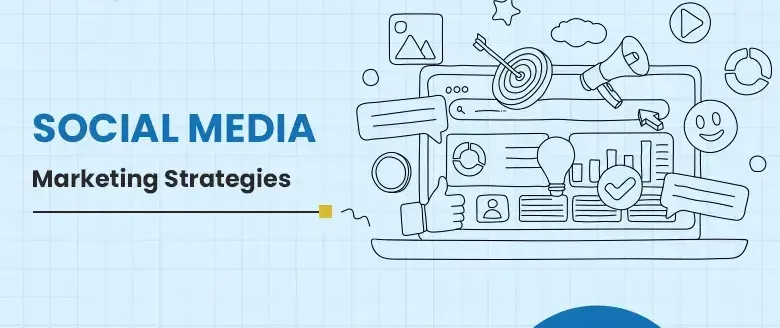Social Media Advertising Tips

Introduction: In today’s digital world, social media advertising tips has become an essential tool for businesses looking to increase their visibility, connect with their target audience, and boost sales. With millions of users across platforms like Facebook, Instagram, Twitter, LinkedIn, and TikTok, the potential to reach new customers is unprecedented. However, to truly harness the power of social media advertising, you need more than just a presence on these platforms—you need to implement effective strategies. Here are several essential strategies for social media advertising that will help you maximize the effectiveness of your campaigns. 1. Know Your Audience: The foundation of any successful social media advertising campaign is understanding your audience. Without knowing who you are targeting, it’s impossible to craft an ad that resonates with them. Define Demographics: Start by defining basic demographic information, such as age, gender, location, income level, and job title. This will help you choose the right platforms and tailor your messaging. Psychographics Matter: Go beyond demographics and think about your audience’s values, interests, and behaviors. What are their pain points? What motivates them to take action? Grasping these elements will allow you to design ads that directly address their wants and needs. Use Social Media Insights: Platforms like Facebook, Instagram, and LinkedIn offer robust analytics tools that allow you to track your audience’s behavior. Use this data to refine your targeting over time. 2. Set Clear Objectives: Before you launch any social media ad campaign, you must define your goals. Are you looking to drive traffic to your website, generate leads, increase brand awareness, or encourage purchases? Your objective will guide everything from the ad design to the budget allocation and performance measurement. Brand Awareness: If your goal is to get people to know your brand, consider using visually striking ads or videos to capture attention. Sponsored posts that highlight your company’s story, products, or services are ideal for this purpose. Lead Generation: If you’re aiming to collect leads, use lead forms directly in the ads to make it easy for users to submit their information without leaving the platform. Sales or Conversions: For driving sales, you might want to focus on retargeting strategies or use carousel ads to showcase multiple products or services. Engagement: If you aim to increase interactions (comments, shares, likes), you can create content that encourages users to participate, such as polls, challenges, or quizzes. 3. Choose the Right Platform: Each social media platform caters to different types of businesses and may not be ideal for all. Each platform attracts a different type of audience and requires unique strategies. Select the platform that best matches the preferences of your target audience. Facebook: With its broad user base and powerful targeting options, Facebook remains one of the most versatile platforms for social media advertising. It’s great for both brand awareness and conversion-based goals. Instagram: If your business is visually-driven (e.g., fashion, travel, food), Instagram can be a fantastic place to showcase your brand. Use a mix of feed posts, Stories, and Reels to capture your audience’s attention. LinkedIn: If you’re in the B2B space, LinkedIn is the platform to focus on. It’s ideal for lead generation, especially for professionals looking for solutions to their business problems. Twitter: For quick updates and real-time engagement, Twitter is perfect. Ads here can be used to promote new content, events, or news. TikTok: If you’re targeting a younger audience, TikTok offers a dynamic and creative platform for advertising. Short, engaging videos are the key to success here. 4. Create Visually Engaging Content: Social media is a visual-first medium. Users scroll quickly through their feeds, so your content needs to stand out. Here are a few tips to create attention-grabbing visuals: Use High-Quality Images and Videos: Ensure your visuals are clear, vibrant, and professional. Poor-quality content can damage your brand’s image and lead to decreased interaction. Follow Platform-Specific Guidelines: Each platform has different size requirements for ads. Make sure you optimize your images and videos to fit these specifications. For instance, Instagram and Facebook both have distinct size requirements for Stories, feed posts, and video ads. Use Animated Content: Animated graphics, GIFs, and videos often perform better because they capture attention more easily. Try to include these elements to keep your ads engaging. 5. A/B Testing Is Key: Running A/B tests, or split tests, is crucial for understanding which elements of your ad campaign are most effective. By testing different versions of your ad—whether it’s the visuals, headline, copy, or CTA—you can learn which combinations resonate best with your audience. Test One Element at a Time: During testing, concentrate on altering just one element at a time. For example, change the image but keep the copy the same, or alter the CTA and keep the design constant. This allows you to identify what drives the best results. Analyze Results: After conducting A/B tests, analyze the results to determine which version performed better. Use this information to optimize future ads and make data-driven decisions. 6. Utilize Retargeting Strategies: Not all viewers of your ad will respond right away. That’s why retargeting is such an effective strategy in social media advertising. Pixel Tracking: Use Facebook Pixel or Google Analytics to track users who visit your website or engage with your content. Then, retarget them with ads tailored to their previous interactions (e.g., products they viewed but didn’t purchase). Custom Audiences: Platforms like Facebook allow you to create custom audiences based on people who have already engaged with your brand. Retargeting ads to these individuals can help increase conversions, as they are already familiar with your business. Sequential Retargeting: You can also implement sequential retargeting, where you show different ads to users at different stages of the buyer’s journey. For example, show a brand awareness ad first, then follow up with a product-focused ad, and finally a discount offer to drive conversions. 7. Set a Realistic Budget and Monitor Performance: Budgeting is a key element of any social media advertising campaign. You want to ensure that you’re spending
Social Media Content Guide

Introduction: In today’s digital landscape, social media has become a vital tool for businesses, influencers, and individuals alike. It serves as an avenue for connection, entertainment and most importantly, marketing. Whether you’re a small business owner, an aspiring influencer, or a content creator, knowing how to create engaging social media content is essential for building a successful online presence. This guide will walk you through the key aspects of social media content creation, providing valuable tips and strategies that can help you craft posts that captivate and resonate with your audience. Understanding Your Audience: Prior to creating content, it’s essential to have a clear understanding of your target audience. Your social media content guide should be tailored to the needs, interests, and values of the people you want to reach. Demographics: Understand the basic demographics of your audience—age, gender, location, income level, and occupation. This helps in tailoring content that appeals to your target market. Psychographics: Go beyond basic demographics to understand the lifestyles, interests, and values of your audience. What drives them? What are their pain points? Creating content that resonates emotionally can lead to stronger engagement and brand loyalty. Engagement Trends: Track when your audience is most active and interactive on social media. This varies across platforms, but knowing the optimal times to post ensures that your content gets maximum visibility. Choosing the Right Platforms: Each social media platform has its own distinct audience and content approach, making them not all the same. Here’s a quick overview of some popular platforms and the types of content that perform best on them: Instagram: Instagram thrives on visuals. Whether it’s photos, videos, or Stories, this platform is perfect for high-quality visuals and behind-the-scenes content. If you’re in fashion, travel, beauty, or food, Instagram is a great place to showcase your products or lifestyle. Facebook: Facebook supports a variety of content formats, such as text updates, images, videos, and external links. It’s ideal for businesses and creators who want to engage with a more mature, diverse audience. Facebook is also great for community-building through groups. Twitter: Twitter is all about concise communication and real-time updates. It’s great for sharing quick thoughts, news, updates, and engaging in conversations with your audience. TikTok: TikTok has rapidly gained global popularity with its captivating short-form videos. If you can create fun, viral-worthy videos or share tips in a creative, engaging way, TikTok is the platform to be on. It’s especially popular among Gen Z. LinkedIn: LinkedIn is primarily a professional networking site, ideal for thought leadership and B2B content. Share insightful articles, professional updates, and industry trends to build your credibility and connect with business-minded individuals. Pinterest: Pinterest is a search engine and social network hybrid, ideal for businesses in lifestyle, DIY, home decor, and fashion. Create pin-worthy content that can drive traffic to your website or blog. Types of Social Media Content: Variety in your content ensures your social media channels stay dynamic and engaging. Below are several types of social media content guide worth exploring: Images: Static images remain one of the most widely used content formats. These can feature product images, inspirational quotes, infographics, or lifestyle visuals that connect with your audience. It’s essential to ensure your images are of high quality and visually engaging. Videos: Video content has been proven to generate higher engagement rates. You can create tutorials, behind-the-scenes footage, customer testimonials, or even short-form videos (such as Instagram Reels or TikTok videos). Keep them short, engaging, and visually interesting. User-Generated Content (UGC): Encourage your followers to create content about your brand, product, or service. UGC can come in the form of photos, videos, or testimonials. Sharing UGC not only gives you valuable content but also builds social proof and community. Stories: Stories (on Instagram, Facebook, or Snapchat) are short-lived posts that are perfect for quick updates, promotions, or behind-the-scenes glimpses. Use features like polls, questions, or countdowns to drive interaction. Blog Posts and Articles: Long-form content, such as blog posts or articles, can be shared on social media to drive traffic to your website. Use social media to tease the post, then include a link for users to read more. Live Videos: Live streaming is a great way to engage your audience in real-time. You can host Q&A sessions, product demos, or live events to foster interaction and build a stronger connection with your audience. Polls and Quizzes: Interactive content like polls, quizzes, or challenges can boost engagement. They are easy to participate in and encourage your audience to interact with your content in a fun way. Creating High-Quality, Engaging Content: Now that you know the types of content, let’s look at some tips for making your posts more engaging and effective. Consistency is Key: Consistent posting ensures your brand remains visible and memorable to your audience. Consistency doesn’t mean posting every hour, but creating a content calendar and sticking to a schedule can help ensure you don’t fall off your audience’s radar. Storytelling: People connect with stories. Narrate stories that highlight your brand, products, or customer experiences. Storytelling humanizes your brand and helps you form emotional connections with your audience. Value-Driven Content: Your content must offer something valuable to your audience. Whether it’s entertainment, education, or inspiration, your audience should feel like they benefit from following you. Offering useful tips, advice, or resources can position you as an expert in your field. Engage with Your Audience: Don’t just create content and wait for the likes and comments to roll in. Actively engage with your audience by responding to comments, asking questions, and showing appreciation for their interaction. This builds a loyal community. Quality Over Quantity: It’s better to post less often with high-quality content than to post frequently with subpar posts. Quality content captures attention and is more likely to be shared by your followers, increasing your reach. Use Hashtags: Hashtags organize your content and increase its visibility to a broader audience. Research relevant hashtags in your niche, but don’t overdo it—5 to 10 hashtags per post
Social Media Marketing Secrets

Introduction: In the current digital era, social media plays a pivotal role in shaping marketing secrets for businesses across the globe. With billions of people active on platforms like Facebook, Instagram, Twitter, LinkedIn, TikTok, and more, social media marketing presents unparalleled opportunities for businesses to engage with their target audience, build brand awareness, and drive sales. However, merely posting content without a strategy or understanding of how these platforms work can lead to poor results. To succeed in social media marketing, there are a few essential secrets every marketer should know. This blog post will explore these strategies, from understanding algorithms to leveraging paid ads, and provide actionable tips for achieving success in the competitive world of social media. 1. Know Your Audience Deeply: The first secret to effective social media marketing is to truly understand your target audience. Social media platforms offer valuable data about user behaviors, interests, demographics, and engagement patterns, making it easier to create content that resonates. Create buyer personas: A buyer persona is a comprehensive profile that represents your ideal customer. This includes not just demographic information like age, location, and gender, but also psychographics, including values, hobbies, pain points, and social media habits. Conduct audience research: Use tools like Google Analytics, Facebook Insights, or Twitter Analytics to gather data about your followers. Look for patterns in their engagement behavior (such as which posts they like, share, and comment on) to refine your content strategy. Segment your audience: Each of your followers is unique, with different interests and behaviors. Some may prefer video content, while others prefer written posts or images. Tailor your content to different segments of your audience to boost engagement. 2. Master the Platform Algorithms: Every social media platform employs algorithms to determine the content displayed to its users. These algorithms prioritize content that resonates with users, typically based on their interactions, interests, and behaviors. Facebook/Instagram: Both Facebook and Instagram use similar algorithms based on user engagement. The more people like, comment, or share your content, the more likely it is to be shown to a larger audience. To improve your reach, post at optimal times when your audience is most active. Also, use interactive content like polls, quizzes, and stories to encourage engagement. Twitter: Twitter’s algorithm prioritizes timely content, meaning tweets with trending topics or those with high engagement are more likely to appear in users’ feeds. Using hashtags strategically can help you join relevant conversations and gain visibility. TikTok: TikTok’s “For You” page is powered by an algorithm that prioritizes videos designed to capture the viewer’s attention within moments. Creating short, engaging, and creative content with popular trends or challenges increases the likelihood of your video being featured on the “For You” page. LinkedIn: LinkedIn’s algorithm favors content that sparks professional conversations, so posting thought-provoking, industry-related content can enhance visibility. Use hashtags to improve discoverability and engage with other posts to increase your reach. 3. Content Is King, but Engagement Is Queen: While creating high-quality content is essential, engagement is what drives long-term success in social media marketing. Engagement not only increases visibility but also builds stronger relationships with your audience. Here are some strategies to boost engagement: Post consistently: Consistency is key to maintaining your presence on social media. Create a content calendar and maintain a consistent posting routine that aligns with your audience’s peak activity times. Encourage user-generated content (UGC): UGC not only saves you time on content creation but also builds trust with your audience. Encourage your followers to share their experiences with your products or services by hosting contests or featuring their posts on your feed. Run polls, surveys, and Q&A sessions: Interactive content like polls, Q&A sessions, and surveys help you engage your audience while collecting valuable insights about their preferences and opinions. 4. Leverage the Power of Influencers: Influencer marketing has become one of the most powerful tactics for enhancing brand trust and expanding audience reach. Influencers have built trust with their followers, and when they endorse your products or services, it can significantly impact your brand’s visibility. Identify the right influencers: Collaborate with influencers whose followers match the characteristics of your ideal customer base. They don’t necessarily need to be celebrities; micro-influencers (those with smaller but highly engaged audiences) can often provide better results. Offer value: When reaching out to influencers, offer something of value in return for their collaboration. This could be free products, services, or monetary compensation. Ensure that the partnership feels authentic and aligns with the influencer’s brand. Measure ROI: Track the performance of your influencer campaigns by monitoring metrics such as engagement, website traffic, and conversions. This will help you assess the return on investment and fine-tune future campaigns. 5. Paid Advertising Can Amplify Your Efforts: While organic growth on social media is crucial, paid ads can significantly accelerate your marketing efforts. Social media platforms like Facebook, Instagram, LinkedIn, and TikTok offer a range of advertising options to target specific audiences with precision. Define your goals: Before launching any paid campaign, clearly define your objectives. Are your objectives to enhance website visits, elevate product sales, or grow brand recognition? Each of these goals demands a distinct approach to advertising. Use advanced targeting: Social media platforms allow you to target ads based on location, interests, demographics, behaviors, and even past interactions with your content. The more precise your targeting, the higher the likelihood of achieving your desired results. A/B testing: Run A/B tests with different ad creatives, copy, and calls to action to determine which combinations perform best. This will enable you to fine-tune your campaigns for the greatest effectiveness. 6. Track, Analyze, and Adapt: To stay ahead of the competition, it’s crucial to constantly monitor the performance of your social media campaigns. Regularly track key metrics like engagement rate, reach, clicks, conversions, and follower growth. Use analytics tools: Each platform has its own analytics tools, and there are also third-party options like Hootsuite and Sprout Social that provide a more comprehensive view of your social media performance. Analyzing
How to Build Social Media Authority

Introduction: In today’s digital world, social media has become more than just a platform for entertainment or socializing. It’s an essential tool for businesses, brands, and individuals looking to build social media authority, grow their influence, and connect with a wider audience. Whether you’re a business looking to increase brand recognition or an individual aiming to establish your personal brand, building social media authority is crucial. But how do you go about it? Build social media authority isn’t a quick fix. Success demands perseverance, commitment, and a well-thought-out strategy. In this post, we’ll guide you through the key steps to building authority on social media, establishing credibility, and growing a loyal following. 1. Understand Your Audience: Before diving into content creation or strategizing about how to engage with your followers, it’s vital to understand who your target audience is. This forms the core of establishing authority on social media. Without understanding your audience’s interests, pain points, and needs, your efforts will be wasted. Ask yourself questions such as: Who are my ideal followers or customers?What are their main challenges?What kind of content do they engage with most frequently? By answering these questions, you can tailor your content and engagement efforts to align with what your audience craves, building authority by becoming a trusted resource in their eyes. 2. Create Consistent, High-Quality Content: On social media, content is king, but it’s not just any content—it’s content that’s consistent and of high quality. To establish authority, you must continuously provide value to your audience. Whether it’s educational content, informative blog posts, entertaining videos, or industry insights, ensure your content resonates with your target audience. Below are a few creative concepts to help spark your inspiration: How-to guides and tutorials: Providing step-by-step guidance positions you as an expert in your niche. Case studies or success stories: Showcasing real-life examples or customer success stories builds credibility. Industry insights and trends: Sharing the latest updates in your industry demonstrates you’re staying on top of trends and developments. Interactive content: Polls, quizzes, or Q&A sessions encourage engagement, building a sense of community around your brand. Additionally, using visuals like high-quality images, infographics, and videos can increase the engagement level of your posts. Visual posts generally receive higher engagement, including more likes, comments, and shares, than text-based content. 3. Engage with Your Audience: Building authority isn’t just about posting content. Social media is, after all, a social platform, so you need to engage with your audience. Engage with comments, address inquiries, and take part in conversations. Engagement is a two-way street, and when you show that you’re invested in your followers’ thoughts and opinions, you build trust and loyalty. Here’s how to enhance engagement: Respond promptly to comments and direct messages. A quick response shows that you care and are actively involved in the conversation. Ask questions to encourage interaction. Straightforward prompts such as ‘What’s your opinion on this?’ or “Have you experienced this?” Has the potential to encourage followers to interact and leave more comments. Host live sessions or webinars. Going live on platforms like Instagram, Facebook, or YouTube allows real-time interaction and strengthens your authority as you showcase your expertise. When people see that you’re approachable and attentive, they’re more likely to trust your opinions and follow you long-term. 4. Leverage Social Proof: Social proof is an essential asset in building authority. When others endorse you, your trustworthiness and impact increase significantly. Social validation may appear as: Testimonials: Positive reviews and endorsements from customers or clients can go a long way in establishing authority. User-generated content: Encouraging followers to share their experiences with your brand or content creates organic, authentic proof of your value. Influencer endorsements or partnerships: Collaborating with influencers in your niche allows you to tap into their audience and establish credibility by association. Displaying your social proof on your social media profiles or within your content not only builds trust but also encourages others to see you as an authority figure in your field. 5. Be Authentic and Transparent: Building authority is not about pretending to be something you’re not. Authenticity and transparency are essential to long-term success on social media. Audiences can tell when someone is being genuine, and they appreciate brands or individuals who are real and open. Here’s how to be authentic: Share personal stories and experiences. People love learning about the human side of the brands they follow. Own your mistakes. If something goes wrong, address it honestly and explain what you’re doing to fix it. This shows your integrity and builds trust. Stay true to your values. Don’t chase trends just for the sake of it. Stick to your core values and communicate them clearly to your audience. When you are authentic and transparent, you show your followers that you’re trustworthy, which is an essential part of building authority. 6. Network and Collaborate: Another effective way to build authority is by networking with other influencers, experts, and brands in your industry. Collaboration is a win-win for everyone involved—it expands your reach, boosts your credibility, and shows that you’re respected in your field. Ways to network and collaborate: Co-host webinars, podcasts, or live events. This allows you to tap into other people’s audiences and share your expertise in a joint setting. Guest blogging. Writing guest posts for other reputable websites in your industry builds backlinks and positions you as a thought leader. Cross-promotions. Teaming up with influencers or complementary brands to promote each other’s content can increase your visibility and credibility. Networking and collaborating with others who have established authority in your niche helps you build your own reputation more quickly. 7. Be Consistent in Your Posting: One of the most important factors in building social media authority is consistency. If you’re only posting sporadically, your audience will forget about you, and you’ll struggle to build a loyal following. Develop a content calendar to ensure you’re posting consistently across your social platforms. While the frequency of posts will vary depending on the platform and audience, ensure you
Social Media Growth Hacks

Introduction: In today’s digital age, social media platforms have become an essential tool for individuals and businesses to communicate, engage, and grow. Whether you’re a personal brand, a small business, or a large corporation, mastering social media growth hacks is crucial for standing out in a crowded online marketplace. With millions of users interacting on platforms like Instagram, Twitter, TikTok, and Facebook every day, growing your social media presence might feel overwhelming. But, don’t worry—there are proven strategies, or growth hacks, that can help you gain followers, increase engagement, and expand your reach efficiently. What Are Social Media Growth Hacks? Social media growth hacks refer to creative, innovative, and often unconventional strategies that help individuals or brands rapidly grow their social media following, engagement, and overall online visibility. These hacks focus on leveraging tools, techniques, and algorithms that help you gain traction quickly and efficiently. The goal is to implement these hacks in a way that doesn’t require extensive time, a huge budget, or advanced expertise, yet produces outstanding results. 1. Optimize Your Profile for Success: Before diving into growth strategies, ensure your social media profile is optimized for attracting followers. Your bio, profile picture, and cover images should clearly communicate who you are and what value you offer. Here’s what to keep in mind: Use a clear and engaging profile picture: Choose a professional photo or logo that represents you or your brand effectively. Write a compelling bio: In just a few lines, explain who you are and what your followers can expect from your posts. Consider adding a call-to-action (CTA) such as “Click the link to learn more” or “DM for collaborations.” Create a consistent theme: Maintain a consistent color palette, fonts, and style across all your posts so that users immediately recognize your brand or personal identity. 2. Leverage User-Generated Content (UGC): User-generated content is an incredibly powerful tool to boost engagement and grow your social media presence. By encouraging your followers to create content related to your brand, you can create an authentic and organic connection with your audience. Here’s how to use UGC: Encourage reviews, testimonials, or photos: Ask your followers to post about your product or service and tag your account. You can re-share their content on your profile to show appreciation. Host contests or challenges: For example, on Instagram or TikTok, run a hashtag challenge and encourage users to participate by posting videos using your branded hashtag. Offering a prize for the best entry can incentivize users to join in. Create a community: By highlighting your followers and customers, you make them feel valued, which can lead to increased loyalty and organic growth. 3. Use Hashtags Strategically: Hashtags can exponentially increase your reach by helping new users discover your content. However, using the right hashtags is key to success. Here are some ways to maximize hashtag use: Use niche hashtags: Instead of going for broad, highly competitive hashtags, find those that are niche and relevant to your content or target audience. This gives you a better chance of being discovered by a targeted audience. Create branded hashtags: Establish unique hashtags related to your brand or campaign. Encourage your followers to use them, which creates a sense of community and increases visibility. Research trending hashtags: Stay up-to-date with trending topics and hashtags in your industry. Using them can help you tap into viral conversations and reach a larger audience. 4. Collaborate with Influencers: Teaming up with influencers is a highly impactful method for boosting your social media presence. Since influencers have built loyal followings who value their insights and endorsements, working with them can expose your brand to a broader audience and accelerate your growth. Find the right influencers: Seek out influencers whose followers match the demographic you’re aiming to reach. Micro-influencers (those with 10,000 to 100,000 followers) can be particularly valuable because they tend to have higher engagement rates. Offer value: Ensure your collaboration is mutually beneficial. Provide influencers with products, services, or exclusive discounts in exchange for shout-outs, reviews, or product demonstrations. Host joint giveaways or campaigns: Running joint campaigns or giveaways can generate buzz and attract new followers. Collaborate on a contest where users must follow both accounts to enter. 5. Post Consistently at Optimal Times: Staying consistent is essential for keeping your social media presence vibrant and engaging. Posting regularly increases the likelihood that your content will be seen by your audience. But timing also plays a crucial role. Each platform has its own peak times when engagement is highest. Use analytics to identify optimal post times: Tools like Instagram Insights, Twitter Analytics, and Facebook Insights show when your followers are most active. Use this data to post during these peak times for maximum engagement. Maintain a content calendar: Plan your posts ahead of time and stick to a regular posting schedule. This ensures that you’re constantly staying visible to your audience. 6. Leverage Stories and Live Streams: Social media stories (Instagram Stories, Facebook Stories, etc.) and live streams are excellent ways to engage your audience in real-time. These formats allow you to share content that feels more authentic and informal, which helps you build a deeper connection with your followers. Post behind-the-scenes content: Stories allow you to give your followers a sneak peek into your life or business operations. This content feels more personal and humanizes your brand. Host live Q&A sessions: Engaging with your audience in real-time is a great way to show that you value their input. Live Q&As, interviews, and product demos can increase your visibility and trustworthiness. Use interactive features: Polls, quizzes, and question stickers on Instagram Stories allow your followers to interact with your content in an engaging way, which encourages more interaction and boosts your algorithm ranking. 7. Repurpose Content Across Platforms: One of the most efficient ways to grow on social media is by repurposing content across multiple platforms. This allows you to reach different audiences while minimizing the time you spend creating content. Adapt your content for each platform: A
Mastering Social Media Campaigns

Introduction: “Mastering Social Media Campaigns” is an essential skill for modern marketers, enabling them to effectively reach and engage their target audience. With the rapid evolution of digital platforms, a well-executed social media campaign can drive brand awareness, customer loyalty, and sales. This involves understanding platform algorithms, crafting compelling content, and utilizing data analytics to measure success. By identifying the right audience and timing, businesses can amplify their message and create meaningful connections. Social media campaigns also demand continuous adaptation to trends, feedback, and new tools. The ability to leverage these elements distinguishes successful campaigns from those that fall flat. Ultimately, mastering social media campaigns requires creativity, strategy, and precision. What is a Social Media Campaign? A social media campaign is a coordinated marketing effort aimed at achieving specific goals through the use of social media platforms. It involves creating and sharing content, engaging with the target audience, and using various strategies to promote a brand, product, service, or cause. The campaign typically includes a series of posts, ads, hashtags, and interactive elements across platforms like Facebook, Instagram, Twitter, LinkedIn, or TikTok, with a clear focus on driving specific outcomes such as increasing brand awareness, generating leads, boosting sales, or fostering community engagement. Success is often measured through metrics like reach, engagement, clicks, conversions, and ROI (return on investment). Why Social Media Campaigns Matter Social media campaigns matter because they offer businesses and organizations a direct, cost-effective way to reach a wide and highly targeted audience. With billions of people using platforms like Facebook, Instagram, and Twitter, these campaigns allow for personalized messaging that can resonate with specific demographics. It is also foster engagement, building stronger relationships between brands and consumers through likes, comments, shares, and other interactive elements. Additionally, they provide valuable data and insights into consumer behavior, enabling brands to refine their strategies. Effective campaigns can boost brand awareness, drive traffic to websites, increase sales, and enhance customer loyalty. Ultimately, social media campaigns are essential for staying competitive in the digital age. Here are crucial because they: Boost Brand Visibility: Reach new audiences and solidify your presence in existing ones. Drive Traffic: Increase website visits and lead potential customers into your sales funnel. Encourage Engagement: Build a loyal community around your brand. Improve ROI: Generate measurable results, ensuring your investment pays off. Steps to Mastering Social Media Campaigns Mastering social media campaigns is essential for businesses looking to effectively engage with their target audience and achieve their marketing goals. With millions of users active across various platforms, a well-executed campaign can significantly boost brand visibility and drive conversions. The key to success lies in understanding your audience, creating compelling content, and strategically using the right platforms. By setting clear goals, managing budgets, and monitoring performance, you can refine your approach for optimal results. Social media campaigns require both creativity and analytics to ensure effectiveness. Follow these steps to create campaigns that resonate with your audience and deliver measurable success. Here are the key steps to mastering social media campaigns that drive results. 1. Define Clear Goals: The initial phase of any effective social media campaign involves setting specific and measurable objectives. What do you want to achieve? Whether it’s increasing brand awareness, generating leads, driving website traffic, or boosting sales, setting clear goals will provide direction for your campaign. Without specific objectives, it becomes difficult to measure success or optimize your efforts. 2. Know Your Audience: Grasping the needs and preferences of your target audience is crucial for developing content that truly connects. Study their demographics, interests, digital habits, and challenges to tailor your approach effectively. This helps you tailor your messaging and ensures you’re reaching the right people. Whether you’re targeting millennials, working professionals, or a niche audience, knowing their preferences will help you craft personalized and relevant content that captures attention. 3. Choose the Right Platforms: Not all social media platforms are created equal. Different platforms attract different user groups, and each has its own strengths. Platforms like Instagram and TikTok are perfect for engaging visual content and reaching younger demographics, whereas LinkedIn excels in targeting B2B audiences. Prior to starting your campaign, select the platforms that align with your objectives and where your target audience is most engaged. 4. Create Engaging Content: Content forms the core of every successful social media campaign. Whether it’s videos, images, infographics, or text, your content should be engaging, creative, and shareable. Ensure that your content addresses the specific needs and interests of your audience in a meaningful way. Consistent branding and messaging across all platforms are also crucial for building a recognizable identity. Remember, great content doesn’t just sell; it tells a story that resonates with your audience. 5. Set a Budget and Schedule: Once your content is ready, set a realistic budget for your campaign. This includes not only paid advertising but also content creation, tools, and resources. Along with budgeting, plan your posting schedule carefully. The timing of your posts is crucial to the overall success of your campaign. Use social media tools to schedule posts for optimal times when your audience is most active. 6. Monitor and Engage: Launching a campaign is just the beginning. Continuously monitor its performance in real-time. Connect with your audience by promptly addressing comments, messages, and feedback. Active engagement helps strengthen relationships and builds trust with your followers. Addressing queries and interacting with customers shows that you care, making them more likely to support your brand. 7. Analyze and Optimize: At the end of the campaign, analyze the results. Look at key metrics such as reach, engagement, clicks, conversions, and ROI. Understanding what worked and what didn’t allows you to optimize future campaigns for better results. Regular analysis and optimization help you learn from your experiences, ensuring your next campaign is even more successful. By following these steps, you can create social media campaigns that are not only effective but also sustainable. With the right strategy, content, and audience engagement, mastering social media campaigns can lead to measurable business growth
Boost Your Social Media Reach

Introduction: In the ever-evolving digital landscape, social media has become an essential platform for businesses, influencers, and content creators to engage with their audience, build relationships, and increase brand visibility. However, with the massive volume of content being shared every second, getting noticed can be a challenge. Boost your social media reach isn’t just about posting content consistently; it’s about crafting the right strategies that help you stand out, engage your audience, and ultimately achieve your marketing goals. In this blog post, we’ll explore practical and effective strategies to help you boost your social media reach and grow your online presence. 1. Understand Your Audience and Tailor Content to Them: One of the foundational elements of social media success is understanding who your audience is. Social media platforms provide a wealth of insights about your audience demographics, behaviors, and preferences. By analyzing this data, you can create highly targeted content that resonates with them. Content that speaks directly to your audience’s interests will encourage engagement, which in turn boosts your reach. Actionable Tip: Use the analytics tools provided by platforms like Instagram Insights, Facebook Analytics, or Twitter Analytics to understand your audience’s age, gender, location, interests, and behaviors. Craft your posts, captions, and visuals to match their preferences. For instance, if you’re targeting younger demographics, short-form content like Reels or TikToks may be more effective. 2. Optimize Your Profile and Content for Each Platform: Each social media platform has its own set of features, trends, and audience preferences. To boost your reach, you need to optimize your content for each platform accordingly. For example, Instagram focuses on high-quality visuals and stories, while Twitter is best for real-time updates and short-form content. LinkedIn, on the other hand, is a great place for long-form articles, professional content, and industry insights. Actionable Tip: Customize your posts to fit each platform’s format. For example: On Instagram, use visually striking images, incorporate hashtags, and take advantage of features like Stories, Reels, and Carousel posts.On Twitter, engage in timely conversations and use relevant hashtags to tap into trending topics.On LinkedIn, share thought leadership articles, success stories, and industry news.By optimizing your content for each platform, you increase the chances of your posts being discovered and shared, which directly enhances your reach. 3. Leverage Hashtags Strategically: Hashtags are a powerful tool for expanding your reach, as they help categorize content and make it discoverable by people outside of your immediate followers. However, using the wrong or irrelevant hashtags can hinder your growth. Researching and utilizing a blend of trending, niche-focused, and broad hashtags that resonate with your audience is crucial. Actionable Tip: Incorporate a mix of custom hashtags, popular trending hashtags, and those tailored to your industry. For instance, if you’re in the fashion industry, you could use general hashtags like #fashion, niche-specific ones like #streetstyle, and your unique branded hashtag like #YourBrandStyle. Tools like Hashtagify or RiteTag can help you identify trending and high-performing hashtags. 4. Post Consistently and At Optimal Times: Maintaining consistency is essential for ensuring your presence remains prominent in your followers’ feeds. Posting regularly keeps your audience engaged and builds brand recognition. However, simply posting frequently isn’t enough. You also need to post at the right times when your target audience is most active. Actionable Tip: Use social media analytics to determine when your audience is online and schedule your posts accordingly. For example, on Instagram, studies suggest that the best times to post are between 9 AM – 11 AM and 2 PM – 5 PM on weekdays. Use tools like Buffer, Hootsuite, or Later to schedule your posts and ensure they go live at peak engagement times. 5. Engage with Your Followers: Social media is not a one-way street. Engaging with your audience builds relationships and helps boost your reach. When you respond to comments, answer messages, and interact with your followers, it encourages more engagement and increases the likelihood of your content being shared or featured in their feeds. Actionable Tip: Actively respond to comments on your posts, like and comment on your followers’ posts, and join conversations relevant to your brand or industry. When someone mentions your brand or products, acknowledge them. 6. Use Visuals and Videos to Captivate Attention: Visual content, especially videos, tends to garner more engagement on social media. Platforms like Instagram and Facebook prioritize video content in their algorithms because it’s more likely to keep users engaged. Videos, GIFs, and infographics stand out in crowded feeds and are more shareable, increasing your chances of reaching a wider audience. Actionable Tip: Create a mix of content that includes eye-catching visuals, short-form videos, tutorials, and behind-the-scenes glimpses of your brand. Take advantage of video features like Instagram Reels, YouTube Shorts, and TikTok to showcase your creativity and connect with your audience in a dynamic way. 7. Collaborate with Influencers and Other Brands: Collaborating with influencers or other brands in your industry helps you tap into their follower base, giving you access to a new audience. Influencers, particularly those with niche followings, can help you build credibility and reach a larger, more relevant audience. Actionable Tip: Find influencers and brands that engage with your target audience without being direct competitors. Reach out to them for collaborations such as joint campaigns, giveaways, or content partnerships. Influencer marketing platforms like Influencity or AspireIQ can help you find the right influencers for your brand. Conclusion: Boosting your social media reach requires a combination of creativity, consistency, and strategy. By understanding your audience, optimizing your content, leveraging hashtags, engaging with followers, collaborating with influencers, and utilizing paid ads, you can significantly increase your social media visibility. The key is to stay adaptable and continually refine your approach based on analytics and feedback. Remember, social media success doesn’t happen overnight. With patience and persistence, you’ll begin to see the impact of your efforts in growing your online presence and boosting your social media reach. Also Read: Mastering Social Media Campaigns
Social Media Strategies

Introduction: In today’s digital era, social media stands as one of the most influential assets available to businesses. Whether you’re a small startup or a global brand, having a solid social media strategy can help you reach a wider audience, build relationships with customers, and ultimately drive sales. However, with the constant changes in algorithms and shifting user behaviors, crafting the right strategy can be challenging. In this blog post, we’ll explore the key components of a successful social media strategies and how to leverage it to boost your brand’s presence. 1. Understand Your Goals and Objectives: Prior to venturing into social media, it’s essential to establish clear objectives. Social media can be used for various purposes, and understanding what you hope to achieve will guide the direction of your strategy. Some common goals businesses pursue through social media include: Brand Visibility: Enhance the recognition and exposure of your brand. Audience Interaction: Foster connections and build trust with your customers. Lead Generation: Capture interest from potential customers or clients. Sales and Conversions: Direct traffic to your website and encourage purchases. Community Building: Foster a loyal following that can become brand advocates. 2. Know Your Audience: A crucial aspect of an effective social media strategy is knowing your audience. Without this insight, your content might not resonate with the right people. Take time to research and define your target audience, considering factors like: Demographics: Age, gender, location, income, education level. Interests: Hobbies, activities, and topics they care about. Pain Points: The challenges your audience is facing that your product or service can solve. Behavior: How they use social media (e.g., what platforms they prefer, how often they engage). 3. Choose the Right Platforms: Not all social media platforms are created equal.Selecting platforms that match both your target audience and business goals is crucial. Below is a brief overview of well-known platforms and their key advantages: Facebook: Great for building brand awareness, hosting events, and running ads. Its diverse user base makes it ideal for reaching a wide audience. Instagram: A platform centered around visual media, perfect for industries like fashion, food, beauty, and lifestyle. Features like Instagram Stories and Reels are widely used for enhancing engagement. Twitter: Perfect for immediate updates, sharing news, and direct interaction with followers. It excels in customer service and fostering brand conversations. LinkedIn: Tailored for B2B marketing, thought leadership, and networking within professional circles. It’s the go-to platform for businesses aiming to cultivate relationships with other companies. TikTok: A relatively new player but growing rapidly, especially among younger audiences. It’s best for creative, short-form video content. 4. Develop a Content Plan: Once you’ve set your goals and selected your platforms, the next step is to create a content plan. Content is king in the social media world, and consistently delivering valuable, engaging material is key to success. Your content strategy should include: Content Types: Decide on the types of content you’ll create, such as blog posts, videos, infographics, product demos, or behind-the-scenes content. The mix will depend on your audience’s preferences and the platform. Engaging Content: Develop content that resonates with the interests and needs of your audience. Ask questions, run polls, and encourage followers to comment or share. Engagement is essential for building a community. Brand Voice: Ensure that your content aligns with your brand’s personality. Whether it’s professional, friendly, humorous, or inspirational, consistency in voice helps create a strong identity for your brand. 5. Use Paid Advertising to Amplify Reach: Organic reach on social media can be limited, especially with algorithm changes on platforms like Facebook and Instagram. Paid social media advertising can help you extend your reach, target specific demographics, and achieve your business goals. Here are a few tips for using paid ads effectively: Targeting: Platforms like Facebook and Instagram offer powerful targeting options, allowing you to reach people based on demographics, interests, behaviors, and more. Ad Formats: Try out various ad formats, such as image ads, video ads, carousel ads, and story ads. Each has its benefits, so test which works best for your objectives. A/B Testing: Run multiple variations of ads to see which ones perform best. A/B testing can help you optimize your campaigns and get the best return on investment (ROI). Budgeting: Start small and scale up your ads once you see what works. Most platforms allow you to set a daily or lifetime budget, making it easy to control costs. 6. Monitor and Analyze Performance: This allows you to identify what’s effective and where adjustments are necessary. Most social platforms provide analytics tools that give insights into metrics like: Engagement Rate: The number of likes, shares, and comments your posts receive. Reach and Impressions: The total audience exposed to your content. Click-Through Rate (CTR): The proportion of individuals clicking on links within your posts or ads. Conversion Rate: How many visitors from social media become customers. 7. Engage With Your Community: Social media goes beyond just sharing your message; it’s about creating open dialogue. Interacting with followers is key to cultivating trust and loyalty. Respond to comments and messages promptly, ask for feedback, and show your appreciation for your community’s support. You can also build relationships by collaborating with influencers or other brands. Influencer marketing can help you reach a larger audience, while partnerships can increase credibility and expand your network. Conclusion: Developing a successful social media strategy takes time and effort, but the rewards are well worth it. By understanding your goals, knowing your audience, choosing the right platforms, creating engaging content, and continuously analyzing performance, you can create a strategy that helps you connect with your audience and achieve your business objectives. Social media is not a one-size-fits-all solution, but with the right approach, it can be a powerful driver of growth and success. Also Read: Boost Your Social Media Reach
